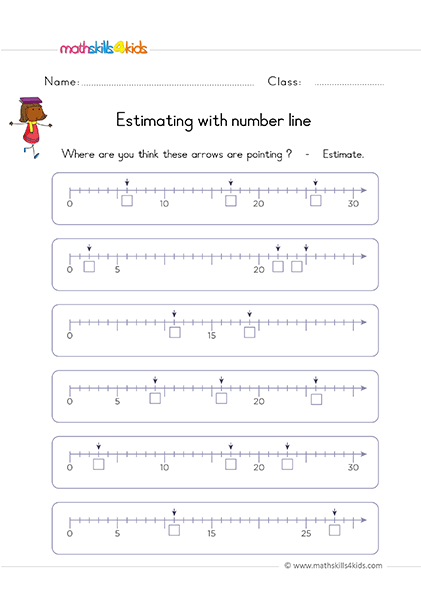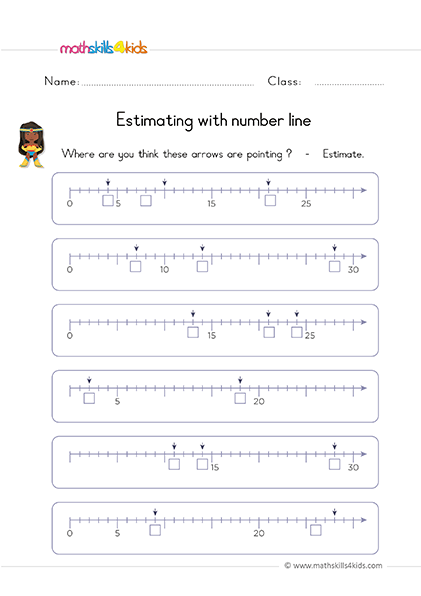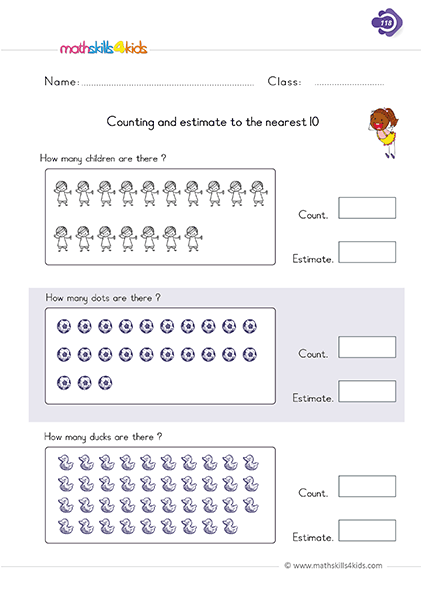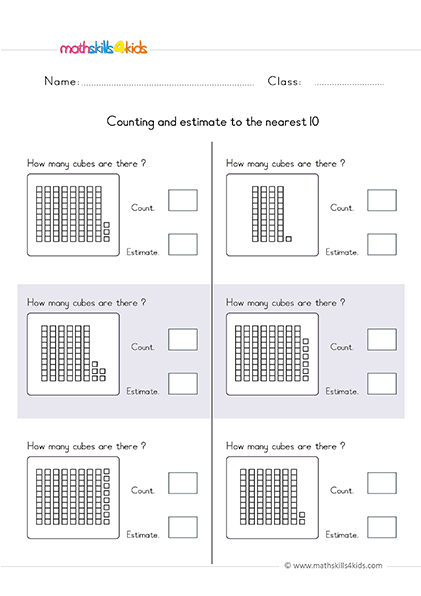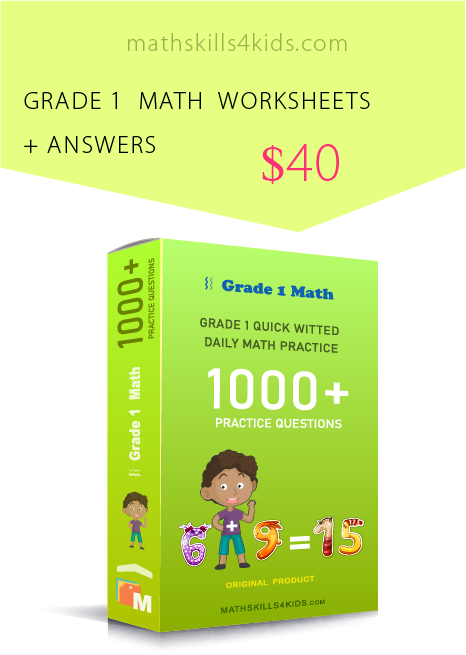1st Grade math estimation worksheets PDF - Mastering rounding and estimation
Are you ready to master rounding and estimation in 1st Grade math? If so, you've come to the right place! On this website page, we have created super fun math estimation worksheets PDF for 1st graders, teachers, and parents. You all will find everything you need to know about estimation and how to use it in different situations.
-
One credible thing about these fun and engaging worksheets is that you can download and print them for free!
Let's get started!
How to teach rounding and estimation using fun and engaging activities
Teaching and learning estimation skills do not have to be boring. Kids have to enjoy the learning process for a better conceptual understanding. Hence we will provide some fun and engaging activities with tips on how to teach rounding and estimation to 1st graders.
With these fun activities, your 1st graders will master the simple rules and strategies of rounding and estimating numbers to the nearest ten and more.
-
BROWSE THE WEBSITE
-
DOWNLOAD FREE WORKSHEETS
-
-
1st GRADE MATH TOPICS
- Counting and numbers
- Understand addition
- Addition skills
- Addition exercises
- Addition strategies
- Understand subtraction
- Subtraction skills
- Subtraction Exercises
- Subtraction strategies
- Mixed operation
- Comparing numbers up to 100
- Estimation Worksheets
- Place value
- Spatial sense
- Graphing & data
- Measurement
- Patterns
- Probability
- Sorting & classifying
- Telling time
- 2D shapes
- 3D shapes - Solids figures
- Fractions
-
-
What is estimation in math?
Before mastering the rules of rounding and estimation, it is important to understand what estimation is first.
Estimation is a way of finding an approximate answer or a reasonable guess for a math problem. Estimation can help you check your work, make decisions, and solve problems quickly and easily.
For example, if you want to buy a toy that costs $7.99 and you have $10, you can estimate that you have enough money to buy it.
-
Why is estimation matters?
Our objective in this resource has also been to enable kids understand why estimation matters and how helpful it is in their everyday life and math problems
Estimation is not only useful for math problems but also for everyday situations.
For example, you can use estimation to:
- Plan your time: You can estimate how long it will take you to finish your homework, get ready for school, or do a chore.
- Manage your money: You can estimate how much something costs, how much change you'll get, or how much you need to save.
- Compare quantities: You can estimate which container has more juice, which pile has more candy, or which group has more people.
- Measure things: You can estimate how long, wide, tall, or heavy something is without using a ruler, a tape measure, or a scale.
Let’s see another example: if you want to buy some candy and you have $5, you can estimate how much candy you can buy by rounding the prices of each candy to the nearest dollar and then subtracting them from your money.
This way, you can avoid spending more than you have or buying too little candy.
Estimation can also help you check your answers when you do math problems. For example, if you are adding two large numbers, you can estimate the answer by rounding each number to the nearest hundred and then adding them.
If your actual answer is very different from your estimate, you might have made a mistake and need to check your work.
-
How to round numbers for estimation
One of the most common ways to estimate is to round numbers. Rounding means making a number simpler or closer to a certain value. For example;
37 is closer to 40 than to 30, so we can round 37 up to 40.
To round numbers, you need to look at the place value of the digits and follow some simple rules:
- If the digit in the place value you want to round is 5 or more, round up by adding 1 to the digit in the place value before it and changing all the digits after it to zero. For example;
To round 67 to the nearest ten, we look at the digit in the tens place (6) and add 1 to it (7), then change the digit in the ones place (7) to zero. So 67 rounded to the nearest ten is 70.
- If the digit in the place value you want to round is 4 or less, round down by keeping the digit in the place value before it as it is and changing all the digits after it to zero. For example;
To round 63 to the nearest ten, we look at the digit in the tens place (6) and keep it as it is (6), then change the digit in the ones place (3) to zero. So 63 rounded to the nearest ten is 60.
- If the digit in the place value you want to round is 5 or more, round up by adding 1 to the digit in the place value before it and changing all the digits after it to zero. For example;
-
Estimation strategies for addition and subtraction
After learning how to estimate and round numbers to the nearest ten, your 1st graders will gradually move to estimating sums and differences practice. To make this practice fun and engaging, we will provide you with the best estimation strategies for addition and subtraction.
One of the easiest strategies to estimate sums and differences is to round each number to the nearest ten, hundred, or other value and then add or subtract them. For example;
If you want to estimate 456 + 789, you can round each number to the nearest hundred and then add them: 500 + 800 = 1300. This is an estimate of the actual answer, which is 1245.
Another way to estimate sums and differences is to use compatible numbers. Compatible numbers are numbers that are easy to add or subtract mentally. For example;
If you want to estimate 456 + 789, you can use compatible numbers such as 450 + 750 = 1200. This is another estimate of the actual answer.
Estimation activities for first graders
Here are three websites that offer some awesome estimation activities for first graders that you can try at home or in the classroom.
- The first website is called We Are Teachers, and it has a list of 18 estimation activities that take the guesswork out of teaching math. These activities include using the "ish" concept, estimating a handful of snacks, introducing estimation jars, building number sense with estimation activities, estimating how many it takes to fill a shape, using building blocks to estimate length, and learning to estimate volume. These activities are fun, hands-on, and easy to set up with everyday objects. 18 Estimation Activities That Take the Guesswork out of Teaching Math (weareteachers.com)
- The second website is called Teaching Expertise, and it has a list of 20 estimation activities to improve kids' math skills. These activities include estimation jars, math and estimation worksheets, rainbow of estimation, how long are my feet, take-home estimation jar, interactive rounding board game, estimating time with songs, estimating weight with balance scales, estimating area with sticky notes, and estimating capacity with water bottles. These activities are creative, engaging, and cover different aspects of estimation. 20 Estimation Activities to Improve Kids' Math Skills - Teaching Expertise
- The third website is called Math Worksheets 4 Kids, and it has a set of 1st grade math estimation worksheets PDF. These worksheets help kids practice rounding and estimation skills with different types of numbers. They include rounding the count to the nearest ten, rounding two-digit numbers to the nearest ten, rounding three-digit numbers to the nearest hundred, estimating sums and differences by rounding, and estimating products and quotients by rounding. These worksheets are simple, effective, and printable. Estimation Worksheets (mathworksheets4kids.com)
Thank you for sharing the links of MathSkills4Kids.com with your loved ones. Your choice is greatly appreciated.
To practice your estimation skills, we have prepared some fun and engaging activities for you. You can also try some online games that will challenge your estimation abilities.
You can download these worksheets for free from our website by clicking on the link below.
Have fun and enjoy learning!
-
